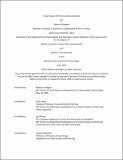| dc.contributor.advisor | Steil, Justin | |
| dc.contributor.author | Glasgow, Rebecca | |
| dc.date.accessioned | 2023-10-18T17:10:51Z | |
| dc.date.available | 2023-10-18T17:10:51Z | |
| dc.date.issued | 2023-06 | |
| dc.date.submitted | 2023-09-18T20:07:08.733Z | |
| dc.identifier.uri | https://hdl.handle.net/1721.1/152499 | |
| dc.description.abstract | By the end of the decade, approximately half of Low-Income Housing Tax Credit (LIHTC)-funded housing units are anticipated to reach the end of their affordability restrictions. This thesis examines the potential benefits and challenges associated with the transformation of LIHTC rental units into homeownership condominium units through an in-depth case study of Quality Hill Phase IIB, a LIHTC Rental-to-Affordable Condominium project based in Kansas City, Missouri. The case study identifies key regulatory and financial factors that contributed to the model’s initial success. Most significant was the legal theory that the Internal Revenue Service (IRS) has no jurisdiction after the 15-year compliance period and sole jurisdiction lies with the State Housing Finance Agency (SHFA). This predicate was the basis for a private letter ruling granted from the Internal Revenue Service, with participation with the SHFA, that allowed a LIHTC tenant the right of first refusal to buy his or her unit as part of the condominium homeownership plan after year 15 of the compliance period. Despite the model’s initial success, the project grappled with substantial obstacles related to the 2008-2012 financial crisis, recapitalization of the capital partner, lack of end loan financing, and tenant eligibility issues that led to its eventual downfall. Despite these challenges, LIHTCto-condominium conversions hold potential as a strategy for creating affordable homeownership options. The case study provides lessons learned and tools to be applied to its application in a future condominium attempt. These include the use of tax codes sections 108, 183 and IRS Revenue Procedure 2014-12 to tackle feasibility of the model as well as securing mortgage financing from alternative lending institutions that can better accommodate to low-income tenants. In conclusion, this research broadens the academic dialogue on rent-to-own models. By highlighting the primary challenges associated with this approach and offering practical insights, this thesis hopes to provide a valuable resource for stakeholders considering LIHTC for affordable homeownership solutions. | |
| dc.publisher | Massachusetts Institute of Technology | |
| dc.rights | In Copyright - Educational Use Permitted | |
| dc.rights | Copyright retained by author(s) | |
| dc.rights.uri | https://rightsstatements.org/page/InC-EDU/1.0/ | |
| dc.title | A Case Study: LIHTC-to-Condo Conversion | |
| dc.type | Thesis | |
| dc.description.degree | S.M. | |
| dc.description.degree | M.C.P. | |
| dc.contributor.department | Massachusetts Institute of Technology. Center for Real Estate. Program in Real Estate Development. | |
| dc.contributor.department | Massachusetts Institute of Technology. Department of Urban Studies and Planning | |
| mit.thesis.degree | Master | |
| thesis.degree.name | Master of Science in Real Estate Development | |
| thesis.degree.name | Master in City Planning | |
